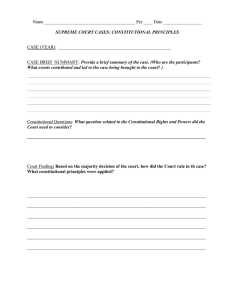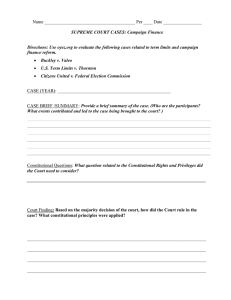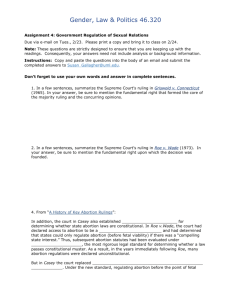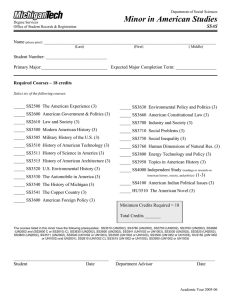Public Opinion and Constitutional Controversy. Edited by Nathaniel
advertisement
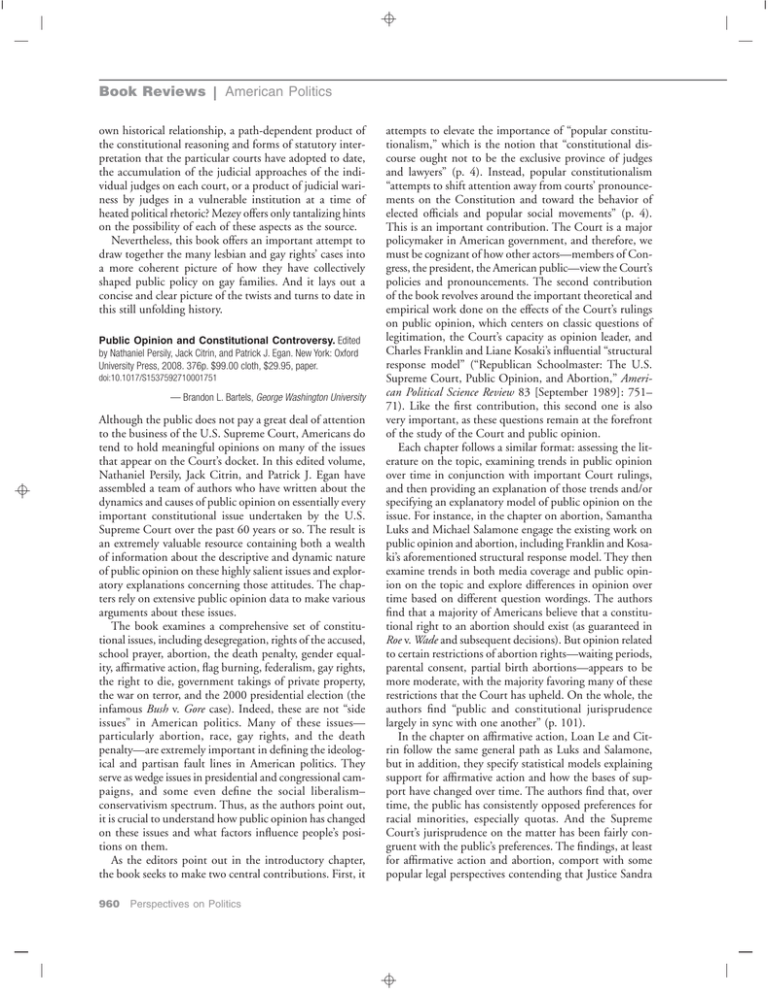
| | 䡬 Book Reviews | American Politics own historical relationship, a path-dependent product of the constitutional reasoning and forms of statutory interpretation that the particular courts have adopted to date, the accumulation of the judicial approaches of the individual judges on each court, or a product of judicial wariness by judges in a vulnerable institution at a time of heated political rhetoric? Mezey offers only tantalizing hints on the possibility of each of these aspects as the source. Nevertheless, this book offers an important attempt to draw together the many lesbian and gay rights’ cases into a more coherent picture of how they have collectively shaped public policy on gay families. And it lays out a concise and clear picture of the twists and turns to date in this still unfolding history. Public Opinion and Constitutional Controversy. Edited by Nathaniel Persily, Jack Citrin, and Patrick J. Egan. New York: Oxford University Press, 2008. 376p. $99.00 cloth, $29.95, paper. doi:10.1017/S1537592710001751 — Brandon L. Bartels, George Washington University 䡬 Although the public does not pay a great deal of attention to the business of the U.S. Supreme Court, Americans do tend to hold meaningful opinions on many of the issues that appear on the Court’s docket. In this edited volume, Nathaniel Persily, Jack Citrin, and Patrick J. Egan have assembled a team of authors who have written about the dynamics and causes of public opinion on essentially every important constitutional issue undertaken by the U.S. Supreme Court over the past 60 years or so. The result is an extremely valuable resource containing both a wealth of information about the descriptive and dynamic nature of public opinion on these highly salient issues and exploratory explanations concerning those attitudes. The chapters rely on extensive public opinion data to make various arguments about these issues. The book examines a comprehensive set of constitutional issues, including desegregation, rights of the accused, school prayer, abortion, the death penalty, gender equality, affirmative action, flag burning, federalism, gay rights, the right to die, government takings of private property, the war on terror, and the 2000 presidential election (the infamous Bush v. Gore case). Indeed, these are not “side issues” in American politics. Many of these issues— particularly abortion, race, gay rights, and the death penalty—are extremely important in defining the ideological and partisan fault lines in American politics. They serve as wedge issues in presidential and congressional campaigns, and some even define the social liberalism– conservativism spectrum. Thus, as the authors point out, it is crucial to understand how public opinion has changed on these issues and what factors influence people’s positions on them. As the editors point out in the introductory chapter, the book seeks to make two central contributions. First, it attempts to elevate the importance of “popular constitutionalism,” which is the notion that “constitutional discourse ought not to be the exclusive province of judges and lawyers” (p. 4). Instead, popular constitutionalism “attempts to shift attention away from courts’ pronouncements on the Constitution and toward the behavior of elected officials and popular social movements” (p. 4). This is an important contribution. The Court is a major policymaker in American government, and therefore, we must be cognizant of how other actors—members of Congress, the president, the American public—view the Court’s policies and pronouncements. The second contribution of the book revolves around the important theoretical and empirical work done on the effects of the Court’s rulings on public opinion, which centers on classic questions of legitimation, the Court’s capacity as opinion leader, and Charles Franklin and Liane Kosaki’s influential “structural response model” (“Republican Schoolmaster: The U.S. Supreme Court, Public Opinion, and Abortion,” American Political Science Review 83 [September 1989]: 751– 71). Like the first contribution, this second one is also very important, as these questions remain at the forefront of the study of the Court and public opinion. Each chapter follows a similar format: assessing the literature on the topic, examining trends in public opinion over time in conjunction with important Court rulings, and then providing an explanation of those trends and/or specifying an explanatory model of public opinion on the issue. For instance, in the chapter on abortion, Samantha Luks and Michael Salamone engage the existing work on public opinion and abortion, including Franklin and Kosaki’s aforementioned structural response model. They then examine trends in both media coverage and public opinion on the topic and explore differences in opinion over time based on different question wordings. The authors find that a majority of Americans believe that a constitutional right to an abortion should exist (as guaranteed in Roe v. Wade and subsequent decisions). But opinion related to certain restrictions of abortion rights—waiting periods, parental consent, partial birth abortions—appears to be more moderate, with the majority favoring many of these restrictions that the Court has upheld. On the whole, the authors find “public and constitutional jurisprudence largely in sync with one another” (p. 101). In the chapter on affirmative action, Loan Le and Citrin follow the same general path as Luks and Salamone, but in addition, they specify statistical models explaining support for affirmative action and how the bases of support have changed over time. The authors find that, over time, the public has consistently opposed preferences for racial minorities, especially quotas. And the Supreme Court’s jurisprudence on the matter has been fairly congruent with the public’s preferences. The findings, at least for affirmative action and abortion, comport with some popular legal perspectives contending that Justice Sandra 960 Perspectives on Politics 䡬 | | 䡬 Day O’Connor, who was a pivotal player in carving out the Court’s legal doctrine in both areas, had her finger on the pulse of public opinion and essentially kept the Court on track with public preferences (e.g., see Jeffrey Toobin, The Nine, 2007). Overall, the book achieves its two broad goals of propagating the concept of “popular constitutionalism” and addressing classic, important questions regarding the congruence between the Court’s decisions and public opinion. While the book covers a rather comprehensive set of constitutional issues, I would like to have seen examinations of two additional issues: freedom of the press and the right to bear arms. Perhaps public opinion data are not as widely available on these topics. On freedom of the press, the Court has, of course, issued several landmark rulings over time. This would also be an interesting topic to analyze in the more recent context of the Valerie Plame leak investigation, where New York Times reporter Judith Miller actually went to jail after refusing to reveal a source to a federal grand jury. I would be very interested in seeing public opinion data on whether people believe the Constitution affords privileged status to communications between reporters and anonymous sources. The Supreme Court has previously ruled that no such constitutional right exists (Branzburg v. Hayes, 408 U.S. 665, 1972). On the second issue, I would also like to see an investigation of whether and under what conditions people believe that there exists a constitutional right for individuals to keep and bear arms. Of course, this book was published in the same year that the Supreme Court issued its landmark ruling that such a right does exist (District of Columbia v. Heller, 478 F. 3d 370, 2008). But controversy around the meaning of the Second Amendment has existed for several years. Indeed, even before the Court issued its Heller ruling, some politicians, and certainly the National Rifle Association, had long been asserting that the Second Amendment protects an individual’s right to keep and bear arms. Finally, I want to say a few words about where this book fits into the political science literature. Work on the Court and public opinion, including this book, typically falls somewhere in between judicial politics/public law and public opinion. But actually, I have found that much of this work is often categorized as judicial politics and public law only. This is unfortunate. My hope is that more of this work will be read widely by scholars of public opinion and political behavior. The authors have made the case for why it is important to understand public opinion on constitutional issues, in conjunction with key Court rulings. As alluded to already, many of the issues on which the Court makes law and policy are central issues in political discourse, which makes this book—and related work—of high importance to the field of American politics writ large. Doorstep Democracy: Face-to-Face Politics in the Heartland. By James H. Read. Minneapolis: University of Minnesota Press, 2008. 224p. $54.00 cloth, $17.95paper. doi:10.1017/S1537592710001763 — John D. Griffin, University of Notre Dame This is at once a how-to book for aspiring politicians and a book with loftier ambitions. The author narrowly lost a 1992 Minnesota state legislative election, and much of the book is an exposition of the notes he assiduously took based on 7,500 doorstep conversations with potential voters. At the same time, the book has a normative point to make—claiming that a “healthy democracy” depends on personal interactions between aspiring politicians and average citizens. The introduction is bold and thought provoking. It argues that face-to-face conversations between candidates and voters are essential to a healthy democracy because both learn from these conversations, because door knocking will lead to more competitive races, and because these conversations will engage citizens in public affairs. “By doorstep democracy,” James H. Read states,” I mean the practice by which an elected official or candidate for elective office initiates in-person conversations with as many of the district’s eligible voters as possible, asks for each individual’s vote, invites substantive discussion of public issues, and allows the voter to codetermine the discussion agenda” (p. 177). After an explanation of how the author became involved in politics, subsequent chapters in the book follow a pattern: On the basis of his campaign notes, he relates a series of anecdotes and ties his experience back to the book’s theme, the significance of personal voter contact. This is easier to accomplish in some chapters than others. In Chapter 2, he classifies the kinds of conversations he had with voters on their doorsteps (i.e., sympathetic, informative, tense, multiissue). In Chapter 5, he summarizes his experience by discussing the specific issue of abortion policy with voters at their homes. In other chapters, the link between Read’s campaign experience and the book’s argument about the importance of personalistic politics is more tenuous. In Chapter 3, he illustrates how he used the media to portray himself as a “hardworking [future] representative,” which was consistent with his door-knocking strategy. However, the book’s principal argument is mostly an afterthought in this chapter. Chapter 4’s discussion of the campaign’s financing is not, to my reading, linked to the doorstep democracy concept at all. The anecdotes related are often telling, but not always. One Holdingford resident who asked for the return of a $20 donation after the author’s pro-life credentials were questioned makes a lasting impression on the reader. Other anecdotes proceed like a parade of barely related memories. In the penultimate chapter, Read recapitulates the final days of the race and sets forth some evidence to support September 2010 | Vol. 8/No. 3 961 䡬 䡬

